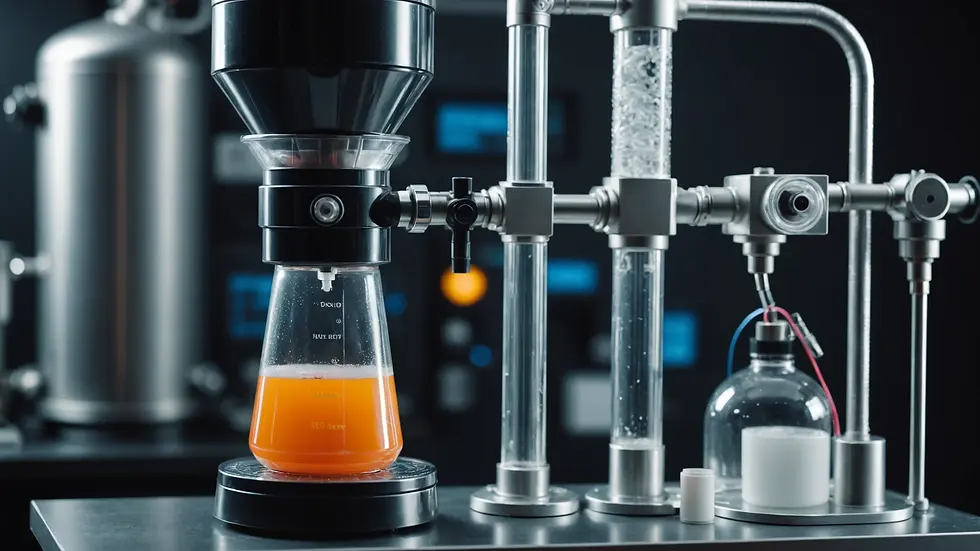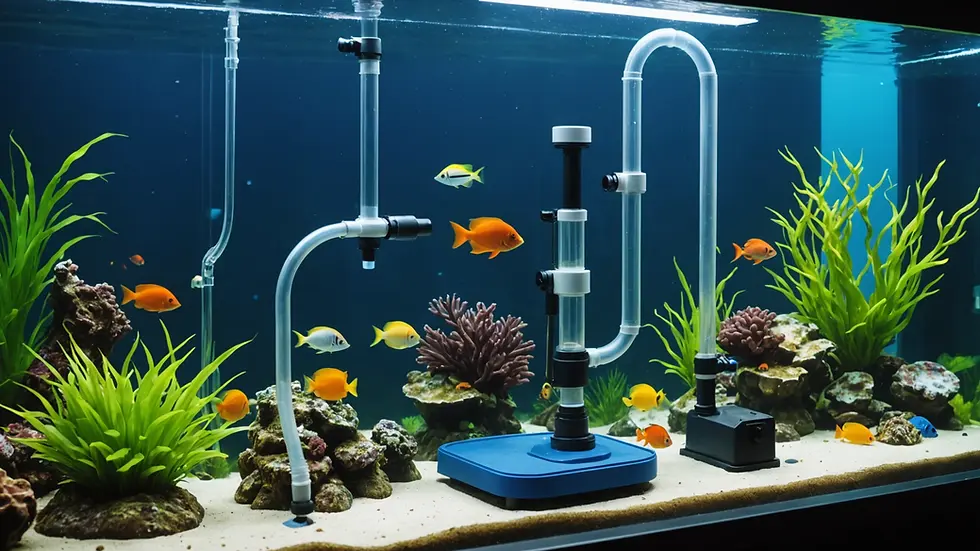Exploring the Mystery of Protein Skimmers: A Beginner's Guide to Aquarium Maintenance
- Jyotiraj Borah
- Feb 12
- 6 min read
Keeping an aquarium healthy is more than just filling it with water and adding fish. For beginners, the task can feel overwhelming. However, one critical tool that simplifies this process is the protein skimmer. This guide will explain what protein skimmers are, how they work, and the types available, making it easier for any aquarium enthusiast to create a thriving marine environment.
What is a Protein Skimmer?
A protein skimmer, sometimes called a foam fractionator, is essential equipment in marine aquariums. Its primary function is to remove organic waste and excess nutrients from water before they can break down into harmful substances. It does this by generating a large number of small bubbles in the water. As these bubbles rise, they trap organic particles and proteins, which are then collected for disposal.
Removing these wastes is crucial for maintaining the water quality in your aquarium. Decomposing organic matter releases harmful compounds such as ammonia and nitrates, which can adversely affect fish and coral health. Regular use of a protein skimmer minimizes these risks and fosters a vibrant aquatic environment.
According to research, using a protein skimmer can reduce ammonia levels by up to 50% in well-maintained systems, significantly lowering the risk of toxicity to fish and corals.
Why is a Protein Skimmer Important?
Protein skimmers significantly enhance water quality, which is vital for all aquatic life. By effectively removing waste, skimmers help maintain cleaner water, which is essential for the well-being of your aquarium inhabitants.
With a protein skimmer, you might extend the time between water changes by up to 30%, saving both time and effort. For example, if you usually perform water changes every week, you might find you can successfully wait ten days or even two weeks with a protein skimmer in place.
In addition, protein skimmers contribute to better oxygenation in the water. The rising bubbles enhance surface agitation, promoting gas exchange and oxygen levels, leading to healthier fish that display more natural behaviors.
How Does a Protein Skimmer Work?
To appreciate the value of a protein skimmer, it's helpful to understand its operation, based on the principle of foam fractionation. Here’s a straightforward breakdown of the process:
Water Inlet: The skimmer draws water from the aquarium, pulling in waste and dissolved proteins.
Bubble Generation: Water mixes with air, producing bubbles. This is typically done using an air pump or a venturi system that introduces air into the water flow.
Contact and Attachment: As bubbles rise, they encounter dissolved organic materials that attach to the bubble surfaces.
Foam Creation: With numerous bubbles coming together, they form foam that collects in the skimmer’s collection cup.
Waste Removal: The foam, containing concentrated waste materials, spills into the collection cup and can be easily removed.
By understanding these mechanics, aquarium owners can better monitor their skimmers, ensuring optimal performance.
Types of Protein Skimmers
Selecting the right protein skimmer is crucial for the health of your aquarium. Different types cater to various needs:
1. Hang-On Skimmers
These are designed to hang on the back of the tank and are ideal for aquariums under 75 gallons. They are easy to set up and maintain but may not perform as efficiently as other types.
2. In-Sump Skimmers
Best suited for larger tanks, in-sump protein skimmers are placed inside the aquarium’s sump. They generally offer increased efficiency and better waste removal than hang-on models, making them a good choice for heavily stocked systems.
3. External Skimmers
External skimmers are positioned outside the sump or aquarium. They provide superior performance, making them suitable for very large aquariums, especially those with a high fish load. However, they often require more complex installation and plumbing.
Choosing the right type of skimmer depends on your tank's size, your budget, and how much maintenance you're willing to undertake.
How to Choose the Right Protein Skimmer
Selecting a protein skimmer involves several considerations. Here’s what to keep in mind:
Tank Size: Ensure the skimmer is rated for your aquarium size. A skimmer that is too small won’t handle the waste effectively. Conversely, one that is too large may be unnecessary if your tank is small.
Bio-load: The number of fish and corals in your tank influences the size and type of skimmer needed. Heavily stocked tanks often require more efficient skimmers.
Footprint: Measure the area you plan to use for the skimmer, ensuring it fits in terms of both height and width, especially for in-sump models.
Budget: Protein skimmers vary widely in price. Decide how much you’re willing to spend while considering that a higher upfront cost might mean better performance and durability in the long run.
Ease of Maintenance: Look for skimmers that are easy to clean and maintain, as difficult-to-access models can lead to neglected upkeep.
Brand and Reviews: Research trusted brands and read user reviews to evaluate performance based on real experiences.
By weighing these factors, you can find a protein skimmer tailored to your aquarium’s needs.
Setting Up Your Protein Skimmer
After selecting the right skimmer, proper setup is essential. Follow these straightforward steps:
Read the Manual: Start by reading the manufacturer’s instructions, as setup requirements can vary by model.
Choose the Location: For hang-on skimmers, secure it firmly to the aquarium. For in-sump skimmers, ensure you have adequate space within the sump.
Install the Air Pump: Connect the air pump as directed in the instructions, ensuring optimal airflow.
Adjust Water Level: Most skimmers function best at specified water levels. Adjust this as per the manufacturer’s guidelines.
Test and Fine-Tune: Run the skimmer for several days to allow foam collection. Check and adjust the water level as needed. Getting the right balance may take some trial and error.
Regular Maintenance: Clean the collection cup frequently and monitor performance to ensure the skimmer runs efficiently.
These steps will ensure that your protein skimmer operates effectively from the start, contributing to a healthy aquarium.
Regular Maintenance of Protein Skimmers
To keep your protein skimmer working efficiently, regular maintenance is key. Here are some best practices:
Clean the Collection Cup: Clean the collection cup at least every week or two, depending on your tank's bio-load. This prevents buildup and maintains efficiency.
Inspect Air Lines and Valves: Regularly check air lines for blockages, and replace any worn parts.
Check for Clogs: Look for blockages in the intake or outlet areas and clear any that are present to maintain optimal flow.
Monitor Water Levels: Keep track of the water level in the skimmer and adjust as necessary to ensure adequate foam production.
Replace Parts if Necessary: Be vigilant about monitoring for wear on components like pump impellers, which can affect performance.
Establishing a regular maintenance routine ensures your protein skimmer remains in top condition, increasing its longevity and effectiveness.
Troubleshooting Common Protein Skimmer Issues
Even reputable protein skimmers can encounter problems. Here are some common issues and practical solutions:
Too Much Foam: If excessive foam is produced, it may be necessary to lower the water level or adjust the air intake.
Not Enough Foam: If foam production is low, check for clogs in the air line or impeller. Clean these parts and ensure the pump works properly.
Noise: Unusual noises may indicate air leaks or a malfunctioning pump. Investigate for leaks and consider replacing any noisy components.
Bubbles in Tank: Excessive bubbles in the tank might signal over-skimming or a poorly configured skimmer. Adjust the settings accordingly to minimize foam.
Poor Performance: If your skimmer isn’t managing waste as expected, evaluate the entire setup. Ensure that water movement is optimal and that the skimmer is adequately sized for your aquarium.
These troubleshooting tips can help keep your protein skimmer functioning at its best, promoting the health of your aquatic ecosystem.
Final Thoughts
Protein skimmers are invaluable tools for maintaining a clean and healthy aquarium. Understanding their function, selecting the right model, and ensuring proper maintenance can create a thriving aquatic environment.
By investing in a suitable protein skimmer and setting it up correctly, you will provide a solid foundation for your tank's health. Your aquarium is a living ecosystem that requires your attention and care.

With knowledge and dedication, you can succeed in aquarium maintenance and see the benefits in the form of healthy, vibrant aquatic life. Embrace the journey of aquarium keeping and let a protein skimmer be your trusted ally along the way.

Maintaining an aquarium is a fulfilling experience. With the right tools, like a protein skimmer, you can enjoy the beauty and peace of marine life right in your home.

Dive into the rewarding world of aquatic care, and create a lush, vibrant ecosystem in your aquarium!




Comments